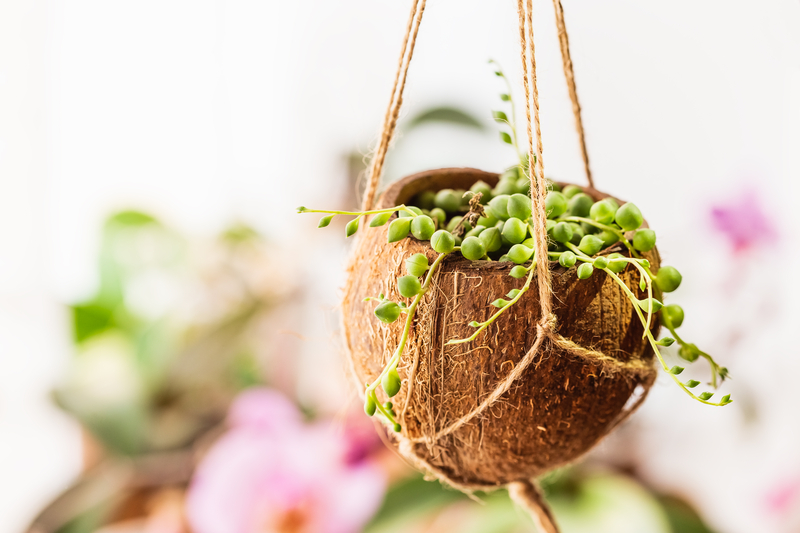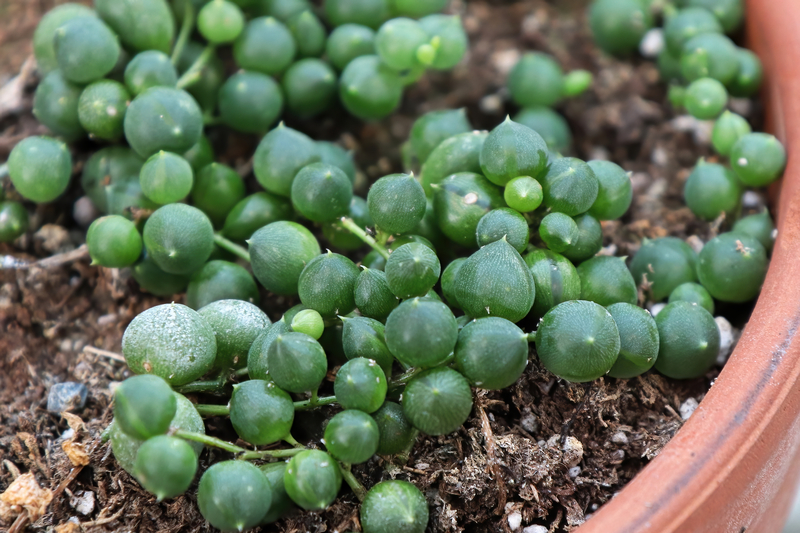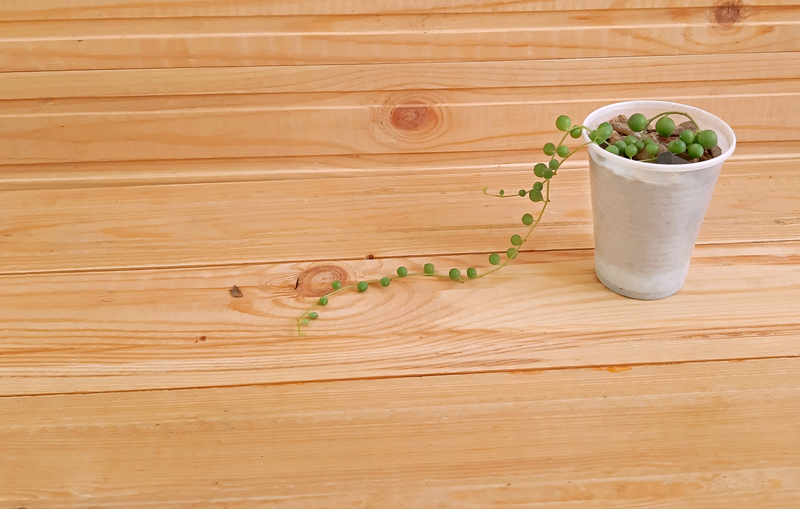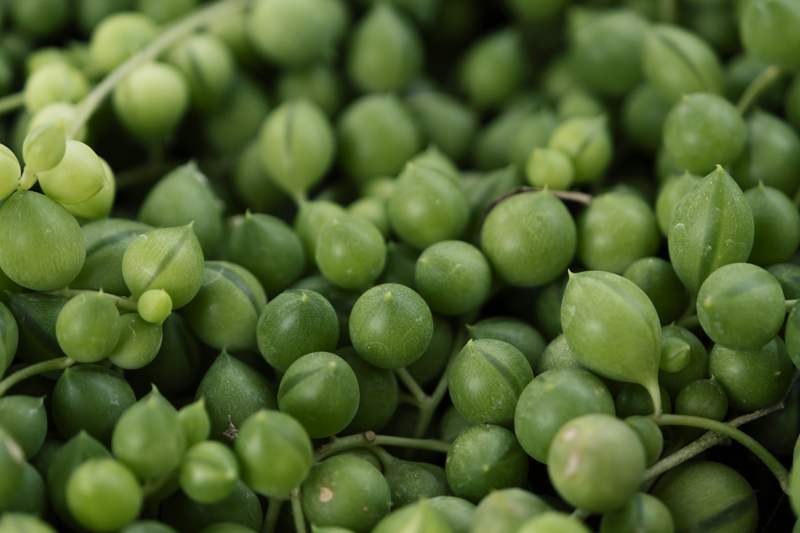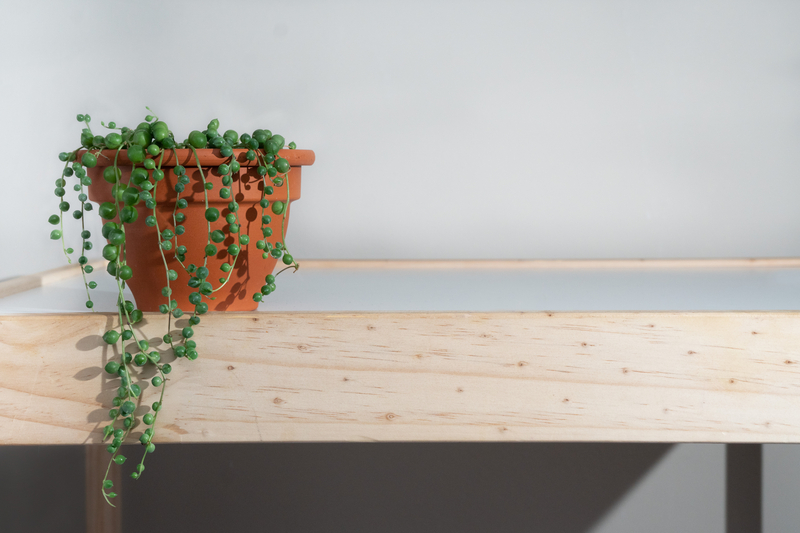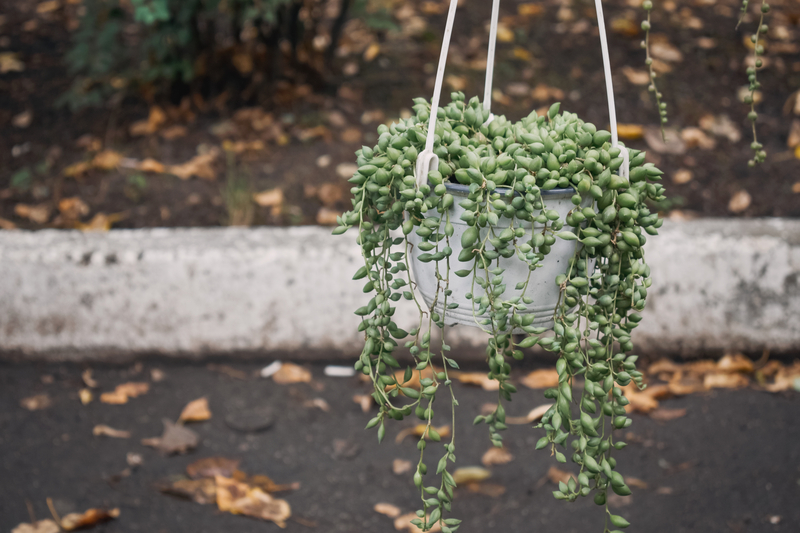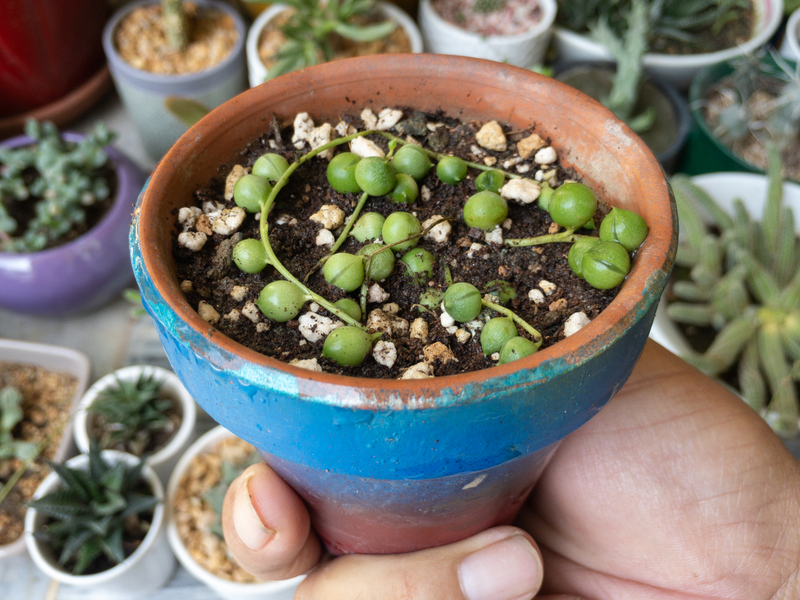A String of Pearls Plant is a cascading succulent that brings a unique look to your home or office with its trailing stems and bead-like leaves. The Senecio rowleyanus is drought tolerant, doesn’t need extra humidity, and functions fine in average home temperatures. Here is how to take care of a String of Pearls Plant effectively.
Common Names
- String of Beads
- Curio rowleyanus
- Senecio rowleyanus
What Soil Mix Works Best for a String of Pearls Plant?
Succulent potting soil works great for this plant. To help reduce the risk of root rot for this plant, you will want to put it in a container with good drainage holes. The drainage holes at the bottom of the pot, like a terra cotta pot, will allow excess water to flow out of the base, which you want.
One tip is to stay away from regular potting soil for this plant. Stay away from regular potting soil because it retains more moisture than succulent soil. Since root rot is a common problem, you will want to stay away from anything that can retain moisture.
Finally, you can consider putting a few coffee grounds into the succulent potting mix for this plant. A String of Pearls Plant does well with a little bit of acidity in their soil, but make sure to use a soil testing kit to measure how much you add. Adding too many coffee grounds will make the soil too acidic, which the plant won’t enjoy.
Can you use Fertilizer?
You can use a well-balanced fertilizer on this plant during the growing season. The suggestion is to give the plant half the dosage of what the bottle says since you don’t want to provide the plant with too many nutrients to absorb. Giving the plant half as much fertilizer is especially true for new plants still settling into your home environment.
How Much Sunlight Does a String of Pearls Plant Need?
A String of Pearls plant does best with bright and indirect light. If you plan to give this plant direct sunlight, you should only do so in the morning since the sun won’t be as intense as in the afternoon. Direct sun in the afternoon can cause damage to the leaves, so be on the lookout for these issues. If you need to leave the plant in front of an east-facing window, you should put a curtain over it to reduce the direct afternoon sun rays.
Signs that your plant is not getting enough light are if the plant becomes leggy. Leggy occurs when the plant is reaching for more bright light. If you notice that the indoor plant has some noticeable spacing between the stems, move it away from the current shaded area and get it into a place with more light, like a windowsill.
What Temperature Works Best for a String of Pearls Plant?
Above 70 degrees Fahrenheit during the summer works excellent for a String of Pearls Plant. During the offseason in the winter months, this plant doesn’t want to be in an environment under 50 degrees Fahrenheit. Be mindful about keeping this plant on a windowsill during the winter, as being near a cold window can cause growth problems.
What Humidity Requirements Does the String of Pearls Plant Need?
A String of Pearls Plant works well with low humidity levels. That means you shouldn’t place this plant in a bathroom with a shower or next to a humidifier since that can cause root rot from the additional moisture. Average humidity levels in a room or office will be sufficient for this plant to grow healthy and strong.
How Often Should You Water a String of Pearls Plant?
You should water this plant once a week during the spring and summer growing seasons. The rule of thumb is to water the plant when the top of the soil is dry. Generally speaking, if the first inch or so of soil is dry, it is a sign that you need to water the plant. Otherwise, this plant is drought tolerant and can go a few extra days without water.
The sign that you are underwatering is if the leaves begin wilting and falling of the plant. If you suspect underwatering, you can give this plant a rinse to remove bugs and dust and allow the water to get deep into the root system. After the rinse, you should let the plant naturally have the excess water flow out of the bottom of the container before placing it back on your windowsill.
What Size Does String of Beads Plants Typically Grow to?
A String of Beads plant grows around one to two feet in their mature height. Since this plant can get a bit big and leggy, you should consider placing it into a hanging basket. The hanging basket would allow the plant to grow a bit out of the container without looking too big if it was on a table or windowsill in your home or office.
Most Common Bugs
Mealybugs, aphids, whiteflies, and gnats are common bugs that attach themselves to a String of Pearls Plant. The most common reason these pests infest this plant is if the plant is in poor lighting conditions, is in an area with too much humidity, or is around other plants with this problem.
To remove these pets from the plant, you can use neem oil and a cloth to wipe down the plant gently. You can also shower this plant in your bathroom or sink to remove bugs, but make sure you allow the excess water to drain and dry off the leaves to reduce fungus.
Most Common Diseases
Root rot is a common problem, like most succulent plants. Root rot occurs from overwatering the houseplant and doesn’t allow the soil to dry before watering it again thoroughly. If you run into root rot, you need to remove the plant from the current container and soil, brush off any dead roots, and repot it into fresh ground.
Can you Prune a Curio rowleyanus?
A Curio rowleyanus is a fast grower, which eventually leads to the plant looking leggy. To help keep the original look of the plant, you will want to trim off any excess branches that are hanging off the container. One tip is to propagate these extra branches if you want to add more plants around your home.
Can you Propagate a String of Pearls Plant?
You can propagate a String of Pearls Plant through stem cutting. The best time to perform stem cuttings is in the early spring or summer when the climate is hot. This plant does the most growing in the warmer months, which works great for propagation. Here are the steps to propagate the plant effectively below.
- Cut around six inches off the plant containing a leaf node at the bottom. You will need the leaf node to be at the very bottom of the cutting since that will create roots for the new plant
- Put the six-inch cutting into a pot with fresh succulent potting mix
- Place the new cutting into an area with bright and indirect light. Keep it away from direct sunlight, if possible, during the early propagation stages.
- Give the plant a few days to settle in the environment before watering it.
Where Does the String of Beads Plant Originate from Originally?
A String of Beads Plant is originally from southwest Africa.
Can you Repot a String of Pearls Plant?
Repotting a String of Pearls Plant is good when the current environment becomes too small for the pant. Signs that repotting is a good idea is if it becomes difficult to remove the plant from the current container because that can illustrate root-bound. Root-bound occurs when the plant’s roots are growing too tightly around the bottom of the pot because they have nowhere else to go since they don’t have space.
To repot the plant, you will want to do this in the spring or summer since that will encourage the plant to grow into the new home. Put the plant into a 1-2 inches bigger container in diameter than the previous home. One tip is to put the plant into a hanging basket when you repot it to allow it to hang off the container a bit if you want that look.
What USDA Zone Works Best?
The USDA Zone that works best for a String of Pearls Plant is 9-12.
Is it Toxic?
This plant is toxic if you digest it. Common problems with this plant if you digest it include diarrhea and vomiting. Also, the plant’s sap might cause skin irritation if you touch it, so make sure to wear gloves when moving this plant.
Conclusion – String of Pearls Plant Care
In summary, having a String of Pearls Plant is ideal for anyone new to plant care. Since the plant is drought tolerant and doesn’t need high amounts of humidity to grow, you can manage it easily in your home or office. Not only is it easy to manage, but it is straightforward to propagate, which means you can give the stem cuttings to friends and family as a gift!

